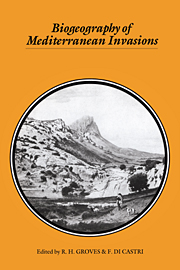Book contents
- Frontmatter
- Contents
- List of contributors
- Preface
- Part I Introduction
- Part II Historical background
- 2 The palaeohistory of the Mediterranean biota
- 3 Human impact on the biota of mediterranean-climate regions of Chile and California
- 4 Central Chile: how do introduced plants and animals fit into the landscape?
- 5 Historical background of invasions in the mediterranean region of southern Africa
- 6 A short history of biological invasions of Australia
- Part III Biogeography of taxa
- Part IV Applied aspects of mediterranean invasions
- Part V Overview
- Index of scientific names
- Subject index
6 - A short history of biological invasions of Australia
Published online by Cambridge University Press: 02 December 2009
- Frontmatter
- Contents
- List of contributors
- Preface
- Part I Introduction
- Part II Historical background
- 2 The palaeohistory of the Mediterranean biota
- 3 Human impact on the biota of mediterranean-climate regions of Chile and California
- 4 Central Chile: how do introduced plants and animals fit into the landscape?
- 5 Historical background of invasions in the mediterranean region of southern Africa
- 6 A short history of biological invasions of Australia
- Part III Biogeography of taxa
- Part IV Applied aspects of mediterranean invasions
- Part V Overview
- Index of scientific names
- Subject index
Summary
Biogeographers have been pre-occupied with the concept of invasions since they began writing about the Australian biota. This theme has perhaps been emphasised so strongly because Australia has been an island continent since it broke from the Gondwanan landmass fifty or more million years ago. The invasion theory has been especially prevalent for Australian plants. In this chapter I shall outline briefly the history of this dominant theme in Australian phytogeography; Barlow (1981) wrote more comprehensively on the same subject and I shall rely heavily on his material in what follows.
Hooker (1860) recognised four elements in the Australian flora:
An Australian or autochthonous element which consisted of plants endemic to the Australian continent
An Antarctic element consisting of plants having close taxonomic affinities with the flora of other southern land masses
An Indo-Malayan element consisting of plants with tropical affinities
A cosmopolitan element consisting mainly of herbaceous plants found in the floras of many other regions.
The concept of invasion and colonisation of the Australian landmass by different floras, perhaps at different times, was inherent in Hooker's subdivisions. His basic ideas prevailed for about 100 years (see e.g. Burbidge, 1960). There were few dissenters from Hooker's concepts until the results of plate tectonic studies became more widely recognised in the 1960s. After all, the main weakness of the invasion theory was the lack of any geographical evidence for the required land bridges, especially that between Australia and South-east Asia.
- Type
- Chapter
- Information
- Biogeography of Mediterranean Invasions , pp. 59 - 64Publisher: Cambridge University PressPrint publication year: 1991
- 5
- Cited by

